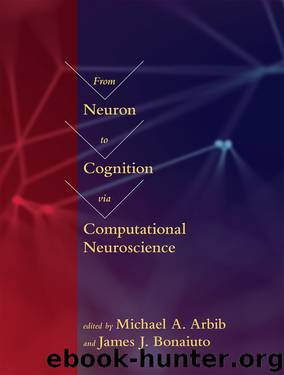From Neuron to Cognition via Computational Neuroscience by Michael A. Arbib & James J. Bonaiuto

Author:Michael A. Arbib & James J. Bonaiuto
Language: eng
Format: epub
Publisher: The MIT Press
Published: 2016-10-11T16:00:00+00:00
where the {bi} are the basis functions (which are the same for all images and could include sinusoids and impulse functions) and the {αi} are the coefficients of the bases (which depend on the image). The number N of bases is much bigger than the dimension of the image, and hence the bases are overcomplete. This differs from Fourier analysis where the data (e.g., an image) are expressed in terms of a set of basis functions which are mutually orthogonal, which enables the coefficients α for each image to be estimated by αi = ∑x bi (x) ∙ I (x). Overcompleteness implies that there are many ways to represent the image in terms of these basis functions (by different choices of the α’s), and we need an additional criterion to select the α’s. The sparsity criterion proposes that we favor representations which make small, which penalize the weights of the basis functions and encourages most coefficients to be 0.
More precisely, we represent an image I by the approximation , where the are chosen to minimize the function
(12.12)
The first term penalizes the error of the approximation, and the second term, whose strength is weighted by a parameter λ, penalizes the coefficients {αi}. The solution cannot be specified in closed form (unlike the case for orthogonal basis functions), but E(α) is a convex function of α, and efficient algorithms exist for minimizing it to estimate . The results of these algorithms can, for example, decompose an image into a sum of sinusoids and a sum of impulse functions.
These ideas give an alternative way to think about the receptive fields of cells in V1. Firstly, observe that V1 has far more cells than the retina or the LGN, and so it has enough neural machinery to implement overcomplete bases. Secondly, overcomplete bases can be designed for specific image structures of interest (e.g., impulse functions or edges), which enables us to start interpreting the image instead of simply representing it. Thirdly, it relates to the observation that cells in V1 fire sparsely, which suggests (Barlow, 1961) that they are tuned to specific stimuli and may relate to metabolic processes (firing a neuron takes energy which needs to be replenished). Hence the idea that the visual cortex seeks to obtain sparse, and hence presumably more easily interpretable, representations has intuitive appeal.
How does this discussion of overcompleteness and sparsity relate to our previous description of V1 cells in terms of Gabor filters? Gabor filters have some of the properties that this approach requires. Families of Gabor filters are built by taking a basic function and performing transformations on it which give an overcomplete basis. Hence they do not specify a unique representation of an image (i.e., any image can be represented many different ways in terms of Gabor functions). These issues, and the relations of Gabors to wavelets, are discussed in more detail in Lee (1996).
Download
This site does not store any files on its server. We only index and link to content provided by other sites. Please contact the content providers to delete copyright contents if any and email us, we'll remove relevant links or contents immediately.
Algorithms of the Intelligent Web by Haralambos Marmanis;Dmitry Babenko(8521)
Test-Driven Development with Java by Alan Mellor(7363)
Data Augmentation with Python by Duc Haba(7261)
Principles of Data Fabric by Sonia Mezzetta(7006)
Learn Blender Simulations the Right Way by Stephen Pearson(6942)
Microservices with Spring Boot 3 and Spring Cloud by Magnus Larsson(6774)
RPA Solution Architect's Handbook by Sachin Sahgal(6175)
Hadoop in Practice by Alex Holmes(6030)
The Infinite Retina by Robert Scoble Irena Cronin(5881)
Jquery UI in Action : Master the concepts Of Jquery UI: A Step By Step Approach by ANMOL GOYAL(5872)
Big Data Analysis with Python by Ivan Marin(5700)
Life 3.0: Being Human in the Age of Artificial Intelligence by Tegmark Max(5401)
Pretrain Vision and Large Language Models in Python by Emily Webber(4659)
Infrastructure as Code for Beginners by Russ McKendrick(4444)
WordPress Plugin Development Cookbook by Yannick Lefebvre(4174)
Functional Programming in JavaScript by Mantyla Dan(4123)
The Age of Surveillance Capitalism by Shoshana Zuboff(4114)
Embracing Microservices Design by Ovais Mehboob Ahmed Khan Nabil Siddiqui and Timothy Oleson(3963)
Applied Machine Learning for Healthcare and Life Sciences Using AWS by Ujjwal Ratan(3937)
